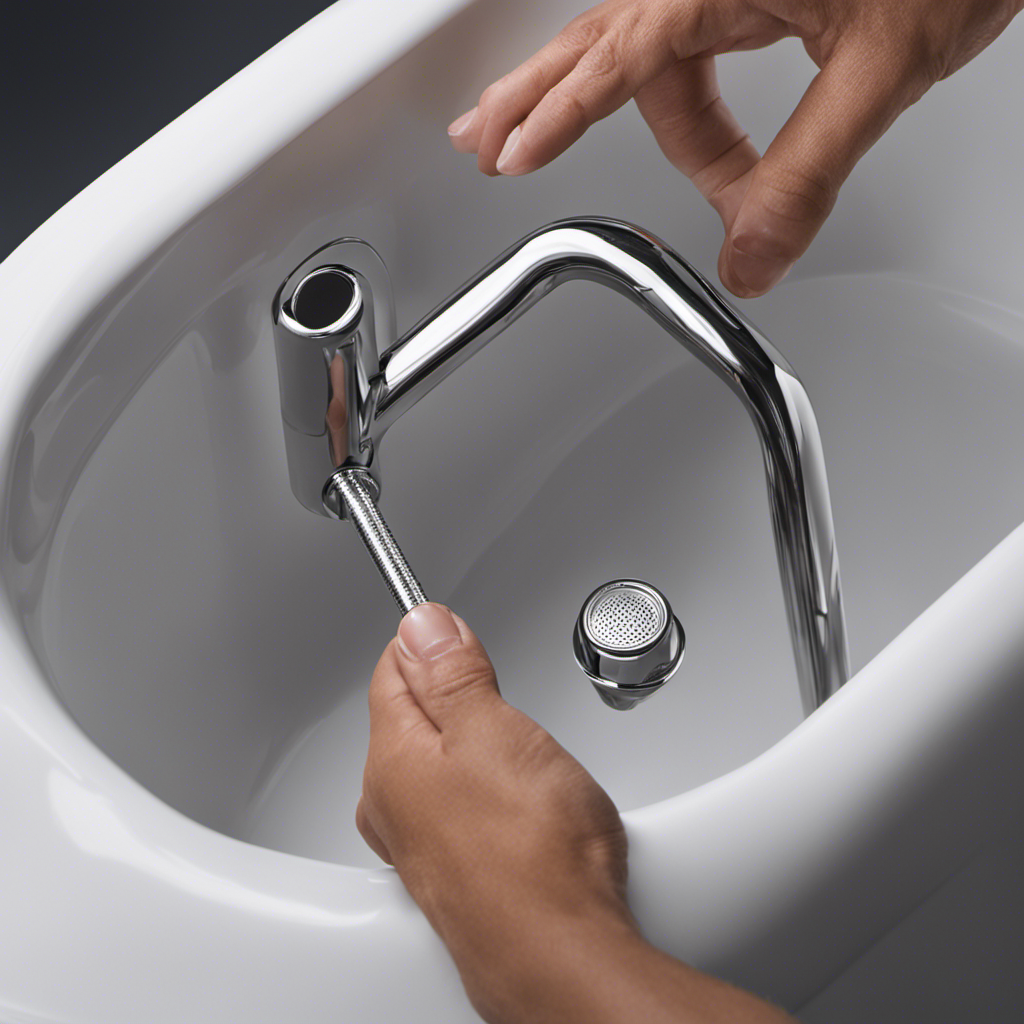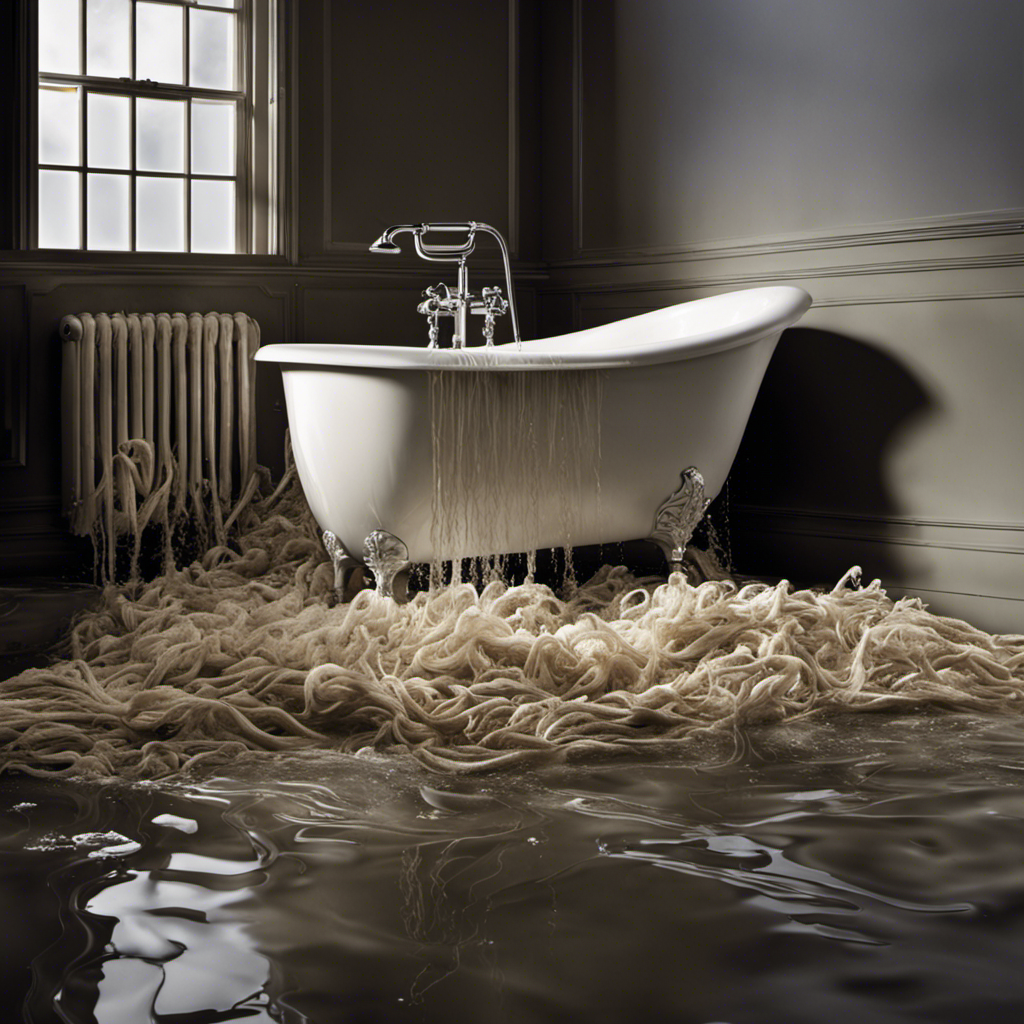I’ve got a simple solution for keeping your bathtub watertight and leak-free. Let me guide you through the process of plugging your bathtub like a pro.
In this comprehensive article, I’ll walk you through selecting the right plug, understanding different types, and providing step-by-step instructions.
Armed with essential tools and expert tips, you’ll be able to seal your bathtub plug with ease. Say goodbye to pesky leaks and hello to a relaxing, worry-free bath experience.
Key Takeaways
- Consider factors like size, material, and effectiveness when choosing a plug.
- Common plug materials include rubber, silicone, and metal.
- Rubber plugs are affordable but may deteriorate over time.
- Silicone plugs are durable and resistant to wear and tear.
Selecting the Right Bathtub Plug
To find the perfect bathtub plug, you’ll want to consider factors like size, material, and effectiveness.
When it comes to bathtub plug materials, there are a few options to choose from. The most common materials include rubber, silicone, and metal. Rubber plugs are affordable and can provide a good seal, but they may deteriorate over time. Silicone plugs are durable and resistant to wear and tear, making them a popular choice. Metal plugs, such as stainless steel or brass, are sturdy and long-lasting, but they can be more expensive.
It’s important to find the perfect fit for your bathtub drain to ensure a tight seal. Measure the diameter of your drain carefully and choose a plug that matches the size.
Additionally, consider the effectiveness of the plug in preventing water from leaking. Look for plugs with a secure grip or suction cup design to ensure a water-tight seal.
Understanding Different Types of Bathtub Plugs
You can easily identify the different types of plugs used for your bathtub by looking at their distinctive shapes and sizes. Here are four common types of bathtub plugs:
-
Rubber plugs: These are the most common type of bathtub plug, made from durable rubber material. They are flexible and can create a tight seal to prevent water from draining.
-
Silicone plugs: These plugs are similar to rubber plugs but are made from silicone material. They are heat-resistant and more durable, making them a popular choice for hot tubs and whirlpools.
-
Pop-up plugs: These plugs have a built-in mechanism that allows you to easily open and close the drain by pushing or pulling a lever. They are convenient and provide a seamless look to your bathtub.
-
Disposable plugs: These plugs are typically made from plastic or rubber and are designed for temporary use. They are inexpensive and can be easily replaced.
When it comes to bathtub plug alternatives, some people prefer using a washcloth or a plastic bag as a temporary solution. However, it’s important to note that these alternatives may not create a secure seal, resulting in water leakage. It’s always best to use a proper bathtub plug for a reliable and effective solution.
Step-by-Step Guide to Plugging a Bathtub
Using a rubber or silicone bathtub plug is a great way to seal the drain and prevent water from escaping during a relaxing bath.
When it comes to bathtub plug alternatives, there are a few options to choose from. One alternative is the traditional rubber stopper, which is inexpensive and easy to use. It effectively seals the drain and prevents water from escaping. However, it may not be as durable as other options and can wear out over time.
Another option is a silicone plug, which is more durable and long-lasting. It creates a tight seal and is resistant to wear and tear. However, these plugs can be more expensive.
Overall, the choice of bathtub plug depends on personal preference and budget.
Transitioning into the next section about essential tools for plugging a bathtub, it is important to have the right tools to ensure a proper seal.
Essential Tools for Plugging a Bathtub
When sealing the drain, make sure you have the right tools for a proper seal in your bathtub. Here are some essential tools you will need:
- Rubber or silicone bathtub plug: These alternatives to traditional plugs provide a tight seal and prevent water from flowing down the drain.
- Plunger: This handy tool can be used to remove any clogs or debris that may be blocking the drain.
- Drain snake: If the plunger doesn’t work, a drain snake can be used to remove stubborn clogs that are deeper in the pipe.
- Wrench: Sometimes, removing the existing bathtub plug may require a wrench to loosen and unscrew it.
By having these tools on hand, you can easily remove and replace the bathtub plug whenever needed.
Now, let’s move on to some tips for properly sealing the bathtub plug.
Tips for Properly Sealing the Bathtub Plug
To ensure a tight seal, it’s important to properly position the rubber or silicone alternative for the drain.
When it comes to sealing techniques for bathtub plugs, there are a few alternative options available. One effective method is using a rubber stopper. These stoppers are designed to fit snugly into the drain, preventing any water from escaping.
Another option is a silicone drain cover. This cover is placed over the drain and creates a watertight seal. It’s important to choose a cover that is the right size for your drain to ensure a proper fit.
Additionally, applying a small amount of petroleum jelly or lubricant to the edges of the stopper or cover can help create an even tighter seal.
Troubleshooting Common Issues With Bathtub Plugs
Now that we’ve discussed how to properly seal a bathtub plug, let’s move on to troubleshooting common issues that may arise. As a bathtub enthusiast, I’ve encountered my fair share of leaking plugs and stuck plugs, but fear not! I have some helpful tips to share with you.
Here are some troubleshooting techniques to address these common problems:
-
Check the rubber seal: Over time, the rubber seal on the plug can become worn or damaged, causing leaks. Inspect the seal and replace it if necessary.
-
Clean the plug and drain: Sometimes, debris and hair can accumulate around the plug, preventing a proper seal. Clean the plug and drain thoroughly to ensure a tight fit.
-
Use a plug wrench: If your plug becomes stuck, try using a plug wrench to loosen it. This tool provides extra leverage and makes it easier to remove the plug.
-
Apply lubrication: If your plug is still stuck, applying a small amount of lubricant around the edges can help loosen it.
Maintenance and Care for Long-lasting Bathtub Plugs
Regular upkeep is essential for ensuring the longevity of your bathtub plugs. By following a few maintenance tips and adopting effective cleaning techniques, you can keep your plugs functioning optimally for years to come. Here are some key tips to keep in mind:
| Maintenance Tips | Cleaning Techniques |
|---|---|
| Avoid pouring harsh chemicals down the drain | Use a mixture of baking soda and vinegar to clean the plug |
| Regularly inspect the plug for any signs of damage or wear | Scrub the plug with a soft brush or sponge to remove any buildup |
| Clean the plug with mild soap and warm water | Use a toothbrush to clean hard-to-reach areas |
| Remove any hair or debris from the plug after each use | Rinse the plug thoroughly with water to remove any residue |
Conclusion
In conclusion, properly plugging a bathtub is not only essential for preventing leaks and maintaining water temperature, but it can also be a simple task with the right knowledge and tools.
By understanding the different types of bathtub plugs and following a step-by-step guide, you can ensure a proper seal and avoid common issues.
Just like how a well-plugged bathtub keeps water from escaping, taking the time to carefully seal our own lives can prevent unnecessary leaks and maintain a sense of balance and peace.










